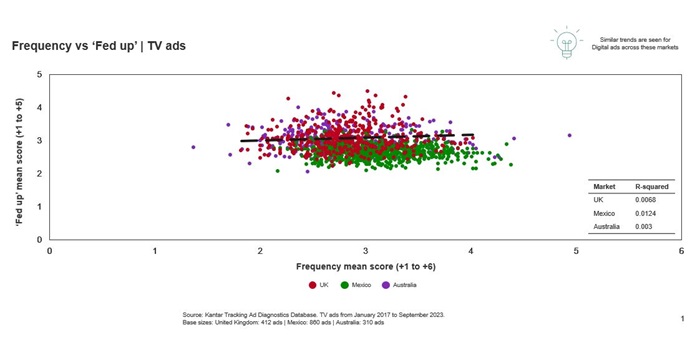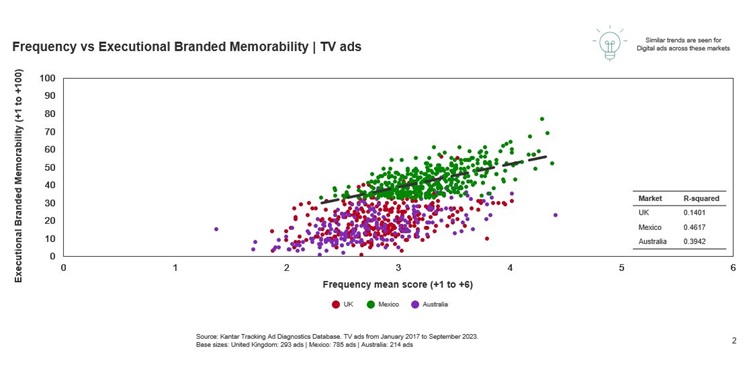Kantar has ~20 years’ experience tracking ads in-market, and over time we’ve found that creative and advertising agencies variously argue two points:
─ Advertising Wear Out is to be expected over time, suggesting a need for new adverts
─ As advertising wears in, audiences enjoy the advert more and ‘get it’ better
While agencies may rally behind their own opinions, Kantar’s ad tracking data holds an evidence-based perspective. At the outset, let’s lock in the definitions, so we’re all on the same advertising page:
─ Wear Out is the negative effect of repeated exposure
─ Wear In is the positive effect of seeing an ad repeatedly or frequently
So what do we actually know about Wear Out and Wear In?
1. Not all ads wear out with repeated exposure. Being ‘fed up’ with an ad (or tired of seeing it) can happen regardless of how many times an ad has been seen. When we plotted Frequency scores against ‘Fed Up’ scores, the best-fit line remained flat; i.e. regardless of how many times an ad is seen, ‘Fed Up’ scores do not tend to increase (Chart 1, total of 1582 tracked ads in 3 markets).

2. Being ‘fed up’ with an ad does not necessarily lead to reduced enjoyment. People can still enjoy an ad that they are tired of seeing. We know this because we looked at the correlation of Enjoyment vs ‘Fed Up’ scores and saw no relationship between these metrics (based on a total of 1645 tracked ads in 3 markets).
3. True Wear Out of creative quality is rare. We found no evidence of creative Wear Out of TV ads in our ad tracking database across several diagnostics (such as Enjoyment, Involvement, Branding and Persuasion). However, digital ads tend to get higher ‘fed up' scores and have a higher likelihood of a dip in enjoyment, particularly in the second burst.
4. Seeing an ad repeatedly does not improve enjoyment. Creative effectiveness (measured by enjoyability of the ad) does not necessarily improve over time – in other words, an ad does not ‘Wear In’ over time and is not likely to be enjoyed more. We saw in our data that no matter how many times an ad has been seen, the Enjoyment score tended to remain the same (analysis based on a total of 1706 tracked ads in 3 markets).
These findings suggest that there are different dynamics at play when it comes to understanding Wear Out and Wear In: Media Saturation and Creative Quality.
─ Media Saturation: We are tracking an increasing number of digital ads across our clients’ tracking programs, confirming the “always-on” nature of the war for consumers’ attention. Using the same creative (particularly video ads) across different media can deliver the multiplier effect, but when there is high frequency involved across all channels, it can be seen as too repetitive and build irritation. An important learning from our work with creative optimisation and media tracking is to tailor creative to the media context while focusing on elements of campaign cohesion.
─ Creative Quality: Our database also shows that Wear Out is not inevitable. There is no evidence to support the notion that over long runs of an ad, its performance ‘runs out’. Strong ads can continue to deliver creative ROI over the long term, if they are allowed to run. In fact, we have found repeatedly that strong ads build brand predisposition, so it is key to only launch an ad when the creative quality is optimal.
So if true Wear Out is rare, and Wear In is a myth used to let poor quality creative on air, then what does repeated exposure actually do?
Ultimately, repeated ad exposure is necessary to create memories strongly linked with brands and helps build predisposition (equity) for them. When we plot Frequency scores against our key in-market effectiveness measure (Executional Branded Memorability) we see a strong positive correlation (Chart 2, based on a total of 1292 tracked ads in 3 markets). This tells us that repeated exposure plays a key role in building branded memorability and hence predisposition.

In summary, repeated exposure doesn't necessarily lead to Wear Out or Wear In. Rather, the chief benefit of repeated exposure (within reasonable bounds) is to create long-term advertising memories that build the brand and heightens brand impact in market.
| We’ve learnt that… | So what? |
| …Repeated exposure of the creative does not necessarily cause Wear Out | Wear Out is not inevitable, other factors such as media saturation and / or poor creative quality can trigger Wear Out. |
| …Wear Out does not necessarily lead to reduced enjoyment | People can still enjoy an ad even if they’re tired of it, so consider multiple perspectives before taking a creative asset off air. |
| …Repeated exposure does not lead to Wear In (improved enjoyment) | Marketers cannot simply rely on repeated exposure to improve enjoyment of the creative over time, a creative asset needs to start off strong to guarantee longevity. |
How can you identify and manage Wear Out?
Marketers need to be careful about flighting an ad with poor creative quality, and effectively manage media saturation. To guide campaign decisions post-launch, look for warning signs of poor in-market effectiveness in ad tracking results, e.g. are people getting tired of seeing ad, enjoying it less, or engaging in a negative way with the ad. Kantar’s BrandCampaign can help you do this in a matter of days, instead of weeks.
Learn more about tracking effectiveness of your ads in-market.
Creative mix optimisation | Kantar Marketplace




